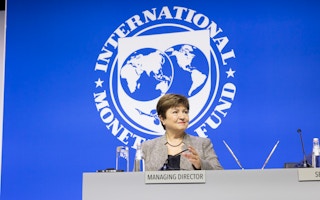Emerging markets and developing economies (EMDEs) are feeling the financial squeeze. Two-thirds of low-income countries are already in or at high risk of debt distress, Russia’s war in Ukraine is compounding financial shocks with high food and energy prices, and the rising cost of capital is leaving governments with little, if any, fiscal space.
At the same time, several EMDEs are bearing the brunt of a looming climate crisis to which they contributed little. Pakistan’s catastrophic flooding last year caused damages and economic losses totalling more than US$30 billion, with reconstruction estimated to cost an additional US$16 billion. In the Caribbean, tropical cyclones regularly cause damage and loss equivalent to around 100 per cent of GDP, and global warming implies that the intensity and frequency of extreme weather is set to increase. And yet, with limited fiscal space and poor access to international markets, EMDEs are unable to invest in climate resilience as needed.
As a key multilateral body charged with promoting global macroeconomic and financial stability, the International Monetary Fund (IMF) is facing a now-or-never moment to help facilitate a just transition to a low-carbon, climate-resilient economy.
Since recognising the profound macroeconomic implications of rising global temperatures, the IMF has released a climate-change strategy, which outlines its plans for integrating the issue into its work, especially its macroeconomic surveillance and lending programs. Most notably, following its historic allocation of US$650 in billion special drawing rights (SDRs, the IMF’s reserve asset) in 2021, the Fund established the Resilience and Sustainability Facility (RSF) in part to support climate action in EMDEs.
The latest United Nations Intergovernmental Panel on Climate Change (IPCC) report sounds the alarm about the rapidly mounting dangers of global warming and the limited time left to adapt. Against this backdrop, a new report from the Task Force on Climate, Development, and the IMF, of which we are members, assesses how the Fund’s climate actions stack up against current needs.
We found that while the IMF has made welcome strides toward integrating climate considerations into its operations, important gaps remain in four key areas: modelling climate risks into its debt-sustainability analysis (DSA); tailoring policy advice to national contexts; upgrading its lending toolkit to address macro-critical imbalances and natural catastrophes arising from climate change; and, along with other institutions, facilitating the large-scale investments needed to help countries shift to a low-carbon pathway
The IMF’s preferred policy prescription has been to set a price on carbon emissions that is high enough to encourage polluters to emit less. Its working papers have suggested a globally coordinated and differentiated price floor to increase policy ambition and foster an orderly transition. Yet while establishing a carbon price is generally considered optimal in theory, implementation and impact raise many challenges.
The introduction of carbon pricing around the world is still uneven and poorly coordinated with national energy policies such as increasing fossil-fuel subsidies. Moreover, several governments are introducing a broad range of instruments to implement climate policies that are better aligned with their unique circumstances. To be sensitive to national needs, the IMF needs to move away from a one-size-fits-all policy and develop an effective method to assess the effects of explicit and implicit carbon prices, which can vary considerably within and across countries.
Carbon pricing is also being embraced as a tool to fund climate investments. But the revenue is unlikely to replace that produced from fossil fuels. This is equally true for hydrocarbon producers, such as those in Latin America and the Caribbean, that rely heavily on fossil-fuel exports for public finance, and hydrocarbon importers that levy significant taxes on fossil-fuel usage.
In addition to expanding its surveillance activities and economic modelling to reflect the reality of diverse national circumstances, the IMF should encourage future-oriented measures such as a big investment push (albeit in a fiscally prudent manner). This would require the Fund to retool its DSA framework to take a broader view of a country’s financing needs.
To meet the UN’s 2030 Agenda for Sustainable Development and their commitments under the Paris agreement, EMDEs will need to mobilise substantial resources, estimated by some to be as much as US$2.4 trillion per year – over two per cent of current global GDP. Beyond that, IMF research has shown that investment in climate-friendly sectors can be a more powerful growth multiplier than investment in carbon-intensive sectors. And, in addition to avoiding costly future damages, investing in climate resilience helps reduce current sovereign risk.
But the IMF’s DSA framework does not properly incorporate countries’ physical climate risks and their fiscal needs for financing a green transition. While the Fund has taken modest steps toward integrating climate shocks into its DSA framework, it is still falling far short in linking program negotiations with climate policy. Until that changes, countries will lack the fiscal space needed to fund the green transition. After all, climate investments cannot be postponed until a country is in better financial health.
As for its lending toolkit, the IMF has modestly increased countries’ borrowing limits. But, overall, the Fund still emphasises short-term fiscal stability at the cost of the longer-term resource mobilisation required to safeguard countries against future climate shocks.
Likewise, the rules for accessing the RSF are too restrictive. As matters stand, a country must have an IMF program in place to access RSF funds. This excludes climate-vulnerable economies that still need to build resilience even if they are not actively in distress. Turkey’s recent earthquake disaster, though not climate-related, is a case in point. Even with broader membership, however, the RSF remains too small to meet current needs and must be vastly scaled up (together with other lending facilities).
The IMF has taken great steps on climate change in a short time. But as the IPCC report concludes, “There is a rapidly closing window of opportunity to secure a liveable and sustainable future for all.” To maximise its impact, the Fund should bear in mind national contexts, tailor its macro-financial models, pay greater heed to the substantial investment push required for low-carbon transitions, and increase the size and scope of its lending tools. None of this will be easy, but ensuring a financially stable and climate-resilient future requires nothing less.
Rakesh Mohan, a former deputy governor of the Reserve Bank of India, is President Emeritus of the Centre for Social and Economic Progress and a member of the Task Force on Climate, Development, and the IMF. Irene Monasterolo, Professor of Climate Finance at EDHEC Business School and EDHEC-Risk Climate Impact Institute, is a member of the Task Force on Climate, Development, and the IMF. Rishikesh Ram Bhandary, Assistant Director of the Global Economic Governance Initiative at the Boston University Global Development Policy Center, is a member of the Task Force on Climate, Development, and the IMF.
Copyright: Project Syndicate, 2023.
www.project-syndicate.org













